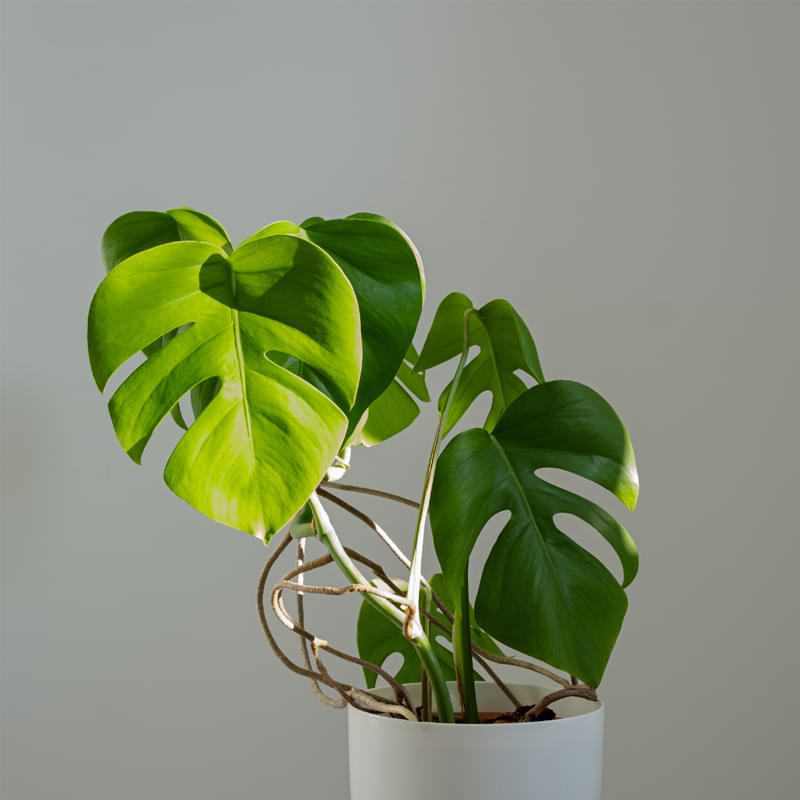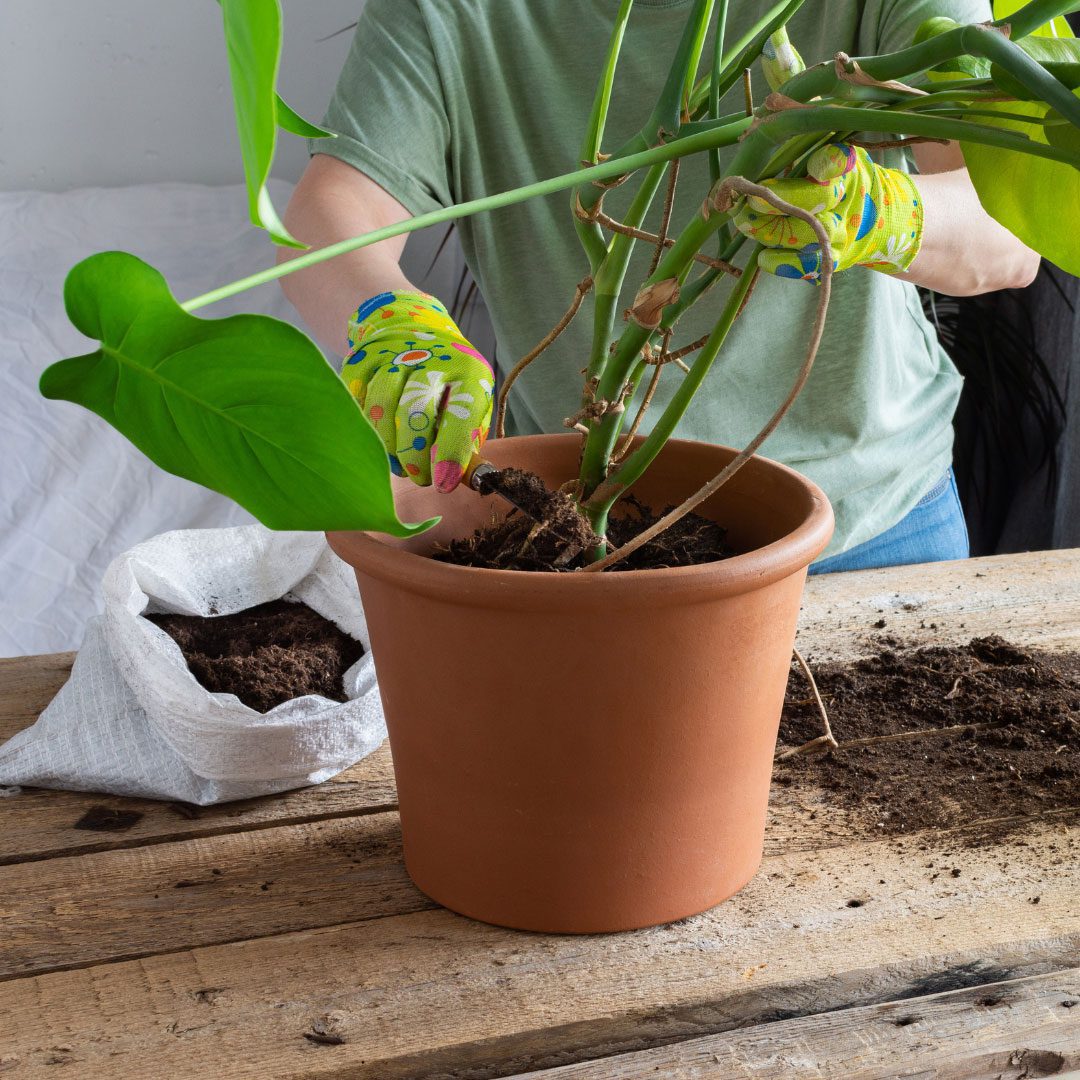With its large and lush leaves, Monsteras can instantly transform any space into a tropical paradise. However, for your Monstera to thrive and reach its full potential, it’s important to give it the right environment to grow in. That begins with what your plant is actually planted in. First, let’s take a look at how Monsteras grow to get a better understanding of what they may need.
Table of Contents
Understanding Monstera Growth Habits
Monstera plants are known for their vigorous and impressive growth habits. Understanding these habits will help you choose the best pot to support your plant’s growth.
Root Growth
The roots play a crucial role in any plant’s overall health and development. The root system of a Monstera plant is extensive and requires ample space to grow freely. As Monstera plants mature, their root systems also develop significantly. You can expect enough root growth to justify repotting your plant every 1-2 years.
It’s essential to periodically check your plant’s roots by gently removing them from the potting mix. If you notice that there are more roots than soil or if they’re wrapping around each other, then it may be time to give your Monstera a larger pot.
Soil Type
The type of soil that you use for your Monstera plant is crucial to its overall health and growth. If you’ve given your Monstera the right soil, you can expect plenty of growth from your plant. If the plant doesn’t have the right soil, it will be harder for your plant to thrive, and you may not see very much extra growth.
When choosing the right soil, it’s important to consider factors such as water retention, nutrient content, and drainage capabilities. A well-draining soil mix is recommended for Monstera plants. This means a soil mixture that holds moisture but also allows excess water to drain away easily. Choosing a mix formulated specifically for Monstera plants is a great option.
Soil Moisture
Overwatering or underwatering can harm the roots of your Monstera, affecting its overall health and growth. You should aim to keep the soil evenly moist, but not waterlogged. You can easily do this by closely monitoring how often you water your plant and using a moisture meter, but the right pot will help do some of the work for you.
When watering your Monstera normally, the pot should allow all excess water to drain from the drainage holes, without holding on to too much water. If you find that you have great drainage, but your soil still isn’t holding enough moisture to keep your plant happy, your soil may be lacking structure, or it may be dry enough to actually repel water. If this is the case, you’ll want to fix the problem quickly so your Monstera doesn’t get dehydrated.
Height and Spread
Monstera plants are known for their impressive size and grandeur, making them a popular choice among plant enthusiasts, but because they can be so large, it can be difficult to pinpoint how big of a container your plant actually needs.
Some Monsteras can grow up to 10 feet tall in ideal conditions! However, their growth rate varies depending on factors such as light exposure, temperature, humidity levels, and pot size. In general, Monstera grows faster during the summer months when provided with plenty of bright but indirect sunlight.
Monstera’s leaves can reach up to 3 feet wide at maturity depending on the variety you have. This means that they require ample room in the pot or surrounding area to allow for proper growth without crowding other plants nearby.

What Size Pot do Monstera Need
Monstera plants are known for their vigorous growth, and they require a pot that can accommodate their expanding root system. As a general rule of thumb, the size of the pot should be one-third to half the size of its spread. This means that if your Monstera has grown to 3 feet in width, you should choose a pot with a diameter between 12-18 inches.
It’s important not to go too big too soon as an oversized pot will hold more soil than necessary and retain excess moisture leading to root rot, disease, or even pest infestations. Instead, gradually increase the size of your plant’s container every time you repot it, which should be about every year if your Monstera is growing at an optimal rate.
When selecting pots for your Monstera, consider both depth and width dimensions. A deep container may encourage downward root growth rather than outward expansion, so make sure to opt for containers with enough space below and around the roots.
Additionally, you’ll need to consider the height of your individual plant. Most Monsteras are vining varieties, and may benefit from a larger container so they can vine out further without toppling the whole pot over.
Ultimately choosing the right size depends on your individual plant and how quickly your plant is growing; inspecting its roots during transplanting helps determine what kind of new home it needs. Always remember that even though Monstera grows quickly doesn’t mean it’s best suited for large pots from day one.
How do I know if my monstera pot is too small?
One way to tell is by observing the plant’s roots. If the roots start growing out of the drainage holes or circling around the bottom of the pot, then it’s time to repot your Monstera into a larger container.
Another sign that your Monstera needs a bigger pot is when its leaves begin drooping or turning yellow. This could indicate that there isn’t enough soil in the current pot to hold sufficient moisture for healthy root growth. This could also be a sign of pests or disease, so use your judgement (and detective skills) to determine what is causing the yellowing. If there are no pests in sight and your plant has otherwise been healthy, it’s likely that it just needs to be up-potted.
Remember: a good rule of thumb is to choose a pot one size up (about 1-2 inches wider and taller) from what you currently have when repotting a Monstera plant.
Pot Composition and Features
When choosing a pot for your Monstera, the composition and features of the pot can make a big difference in the plant’s growth and health. There are so many options out there to choose from that it can be quite overwhelming.
Terracotta Vs Plastic
Terracotta pots are made from clay and offer several benefits. They’re porous, which means excess water can evaporate through the sides of the pot and help prevent over-watering. The downside is that they dry out quickly, so frequent watering may be required in warmer months or when the air is particularly dry. Additionally, terracotta pots can become heavy when filled with soil, making them difficult to move around.
Plastic pots are lightweight and easy to handle. They also retain moisture well, meaning less frequent watering is necessary compared to terracotta pots. However, plastic does not allow for air circulation like terracotta does which could lead to root rot if overwatered. Depending on the type of plastic pot, it may leak toxins from the plastic into your plant’s soil.
Ultimately, the choice between a terracotta or plastic pot depends on your specific needs as a plant parent, your individual plant, and what look you like the best.
Drainage Holes
Drainage Holes are an essential feature to look for when selecting a pot size and type for your Monstera plant. These holes allow excess water to escape, preventing the roots from becoming waterlogged. When roots sit in standing water, they can quickly become damaged and begin to rot.
Without drainage holes, the soil will retain too much moisture and create a breeding ground for harmful bacteria that can cause root rot or other diseases. This is why it’s important to always choose pots with drainage holes located at the bottom of the container. If you really like a certain pot that doesn’t have drainage holes, consider putting them in yourself using a drill before putting your plant in the pot. Do not let your plant sit in a pot without drainage holes.
Drip Tray
A drip tray, as the name suggests, is a container that catches excess water from the pot. It’s placed under the pot to protect surfaces from damage caused by water leakage or overflow. Having a drip tray is good to have for your Monstera because it helps maintain soil moisture levels, provides an easy clean way for your plant to drain extra water, and can even serve as a humidity tray, provided the water in the tray is not touching the soil in the bottom of the pot.
You can also add some pebbles inside your drip tray to create an even surface for better drainage flow and aesthetics. Remember that while having a drip tray is great, make sure not to leave standing water in them for too long as this may attract pests like mosquitoes.
Decorative / Cache Pots
Decorative or cache pots are a popular choice for many plant parents when it comes to showcasing their beloved Monstera plant. These pots come in various colors, designs and materials that can complement any decor style.
However, while decorative pots may be aesthetically pleasing, they may not always be the best option for your Monstera’s growth. Decorative pots often lack drainage holes which, as we learned, can lead to water build-up and root rot
If you still want to use a decorative pot for your Monstera, you can opt for one with an inner plastic container that fits inside the outer pot. This way, you can easily remove the plastic container during watering time to avoid overwatering and ensure proper drainage. Just ensure there is space between the bottom of the decorative pot and the inner lining, so the soil and roots aren’t sitting in the water that drains into the pot. Additionally, you can also create your own drainage holes. The material of the pot will determine how to do this safely, but it’s typically always possible to add in drainage.
Ultimately, if you choose to go with a decorative pot as opposed to traditional terracotta or plastic ones, make sure it has proper drainage and is not too big for your Monstera’s needs.
Pots to Avoid for Monstera
When it comes to potting your Monstera, there are a few types of pots you should avoid, including metal and glass, but most importantly, you should always avoid self-watering pots.
Self Watering Pots
Self-watering pots may seem like a convenient option for busy plant parents, but they are not always ideal for Monstera. Self-watering pots work by having a reservoir of water at the bottom that gradually wicks up into the soil as needed. However, this can lead to overwatering and root rot if not monitored carefully. Additionally, Monstera prefers slightly dry soil in between watering sessions, which might not be possible with a self-watering system.
Self-watering pots have been known to kill many plants either because of the root rot they caused or because the standing water under the plant perfectly supports the breeding of bacteria and diseases that can quickly kill most plants. Even though it seems convenient, stay away from self-watering pots. Besides, having to water your plant regularly gives you more time to enjoy them!
More Monstera Resources
Learn more about caring for these amazing plants!






